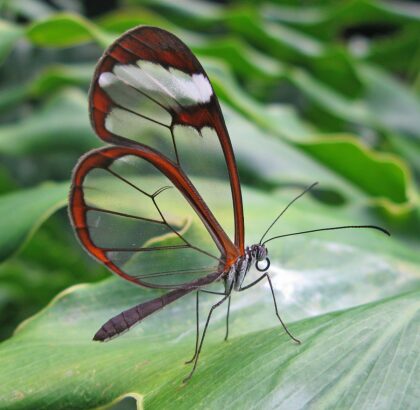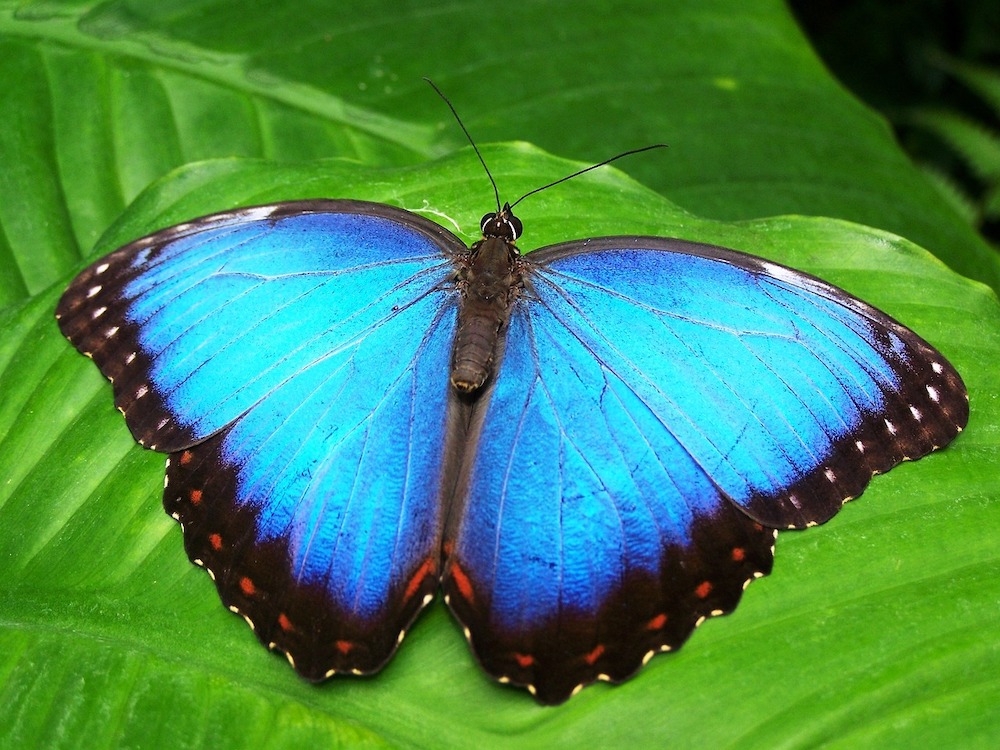Butterflies and moths, with their vibrant colors and intricate patterns, are more than just enchanting creatures flitting through our world. They play a pivotal role as pollinators, and are important for the reproduction of numerous flowering plants. Butterflies and moths are also a source of inspiration and research for scientists. PBS NOVA recently did a segment on the technological insights that we can gain from butterflies. The show inspired this column after I discovered that there is even more that we could learn from butterflies.
Butterflies or moths dart about for only three weeks to six months, depending on the species and environmental conditions. Despite their brief existence, butterflies offer important insights into the natural world’s intricacies. Science has explored the nanoscopic structure of butterflies’ and moths’ wings and antennae, uncovering secrets that can advance our own technology.
The best-known product from moths and butterflies is silk, produced by the Bombyx moth caterpillar, also referred to as a silkworm. Each caterpillar can spin up to a mile of silk fiber, which has long been a staple in the textile industry.
However, silk’s utility extends beyond clothing. Scientists have identified two primary proteins in silk: fibroin and sericin. At Tufts University, researchers are looking at fibroin for potential medical applications. By dissolving the fibroin protein in water and subsequently removing the water, they can create a versatile substance that is either flexible for bandages or as hard as Kevlar for medical implants. This natural material does not trigger inflammatory responses, making it well-suited for medicine. Current research is exploring its use as surgical screws.
There is even more that we can learn from the Bombyx moth. The antenna of the male is so sensitive to scent that it can detect a female 6 miles away. Simulating the antenna’s nanostructure, scientists hope to be able to detect dangerous compounds (e.g., sarin) from a distance. Attached to drones, a sensilla structure (which is used by the moths to detect scents) could warn the general population of contaminants or dangerous chemicals from miles away.
There is even more. Scientists have also identified cocoonase, an enzyme in the Bombyx and other butterflies and moths that breaks down blood clots in the test tube. Like fibroin, it is compatible with human biology and could dissolve blood clots in the human body.
That is a lot for one species. But another species, the beloved male Blue Morpho butterfly is equally intriguing to scientists.

Blue Morpho
The iridescent blue wings of the male Blue Morpho butterflies have long fascinated people and scientists. The Blue Morpho does not use pigment to create its bright blue iridescent color on its wings. Rather than absorb and reflect certain light wavelengths as pigments and dyes do, their wings have a layered microstructure that causes light waves to hit the surface of the wing to diffract and interfere with each other so that certain color wavelengths cancel out while others, such as blue, are intensified and reflected. The Morpho’s colors are a structural color, reflecting only blue light due to the wings’ unique nanostructure. At the University of Rochester, researchers are studying this phenomenon to develop light-absorbing materials for solar panels. By mimicking the Morpho butterfly’s nanostructure, they can create an absolute black which will increase solar panel efficiency by 130%.
A technology known as plasmonic color display screen is made up of self-assembled nanostructures based on the Blue Morpho’s wing structure. These screens reflect light to create a more natural look and use less energy. The technology mimics the technique used by male Morpho butterflies to create color by scattering and reflecting light on the microstructures on their wings.
Another beautiful species can also contribute to solar technology. The Glass Wing butterfly has wings that are transparent without reflectivity. This is not currently available in transparent materials that we use, for example, glass has approximately a 10% reflectivity. Like the nanostructure of the Blue Morpho butterfly, the transparent wing nanostructure of the Glass Wing butterfly has significant implications for solar technology. By eliminating reflectivity, solar panels can absorb more light, improving their efficiency.
The nanotechnology of the Glass Wing butterfly wing can also be used in cell phones, tablets, and other devices to eliminate glare.
At Caltech, scientists are also investigating the nanotechnology behind the Glass Wing butterfly’s transparency to create eye implants that monitor the progression of glaucoma. 
Another butterfly can help us with the design of more efficient solar panels. The common cabbage white butterfly’s wing structure allows it to efficiently use the sun’s rays to warm its body. The configuration of the cabbage white wing can be combined with butterfly nanostructures to further improve the efficiency of solar panels.
All butterfly wings possess a natural ability to repel water, absorb heat, and control the flow of vapors. Scientists are looking into that nanostructure for other applications. A butterfly cannot survive with water on its wings, so its wings have a unique microstructure that repels water and cleans the wing. Understanding these nanostructure properties could have far-reaching technical applications, including the construction of ships with water-repellent surfaces and metals that “float.” This unique nanostructure also has applications in self-cleaning surfaces, protective clothing, and sensors.
Another special butterfly is the Green Hairstreak butterfly, which is native to areas from the UK to Siberia. The Green Hairstreak’s wing has one important difference from other butterflies. Its nanostructure forms a unique optical material. This structure allows the splitting of circular polarized light and can be used in telecommunications for developing integrated photonic circuits for optical communications, imaging, computing and sensing.
Wow.
From medical applications to solar energy advancements to non-glare screens, butterflies can guide us toward a future where technology takes advantage of the evolution of the natural world. As we continue to unravel the mysteries of butterflies, we enhance our own technological capabilities, and deepen our appreciation of these beautiful insects.
Angela Rieck, a Caroline County native, received her PhD in Mathematical Psychology from the University of Maryland and worked as a scientist at Bell Labs, and other high-tech companies in New Jersey before retiring as a corporate executive. Angela and her dogs divide their time between St Michaels and Key West Florida. Her daughter lives and works in New York City.



Write a Letter to the Editor on this Article
We encourage readers to offer their point of view on this article by submitting the following form. Editing is sometimes necessary and is done at the discretion of the editorial staff.